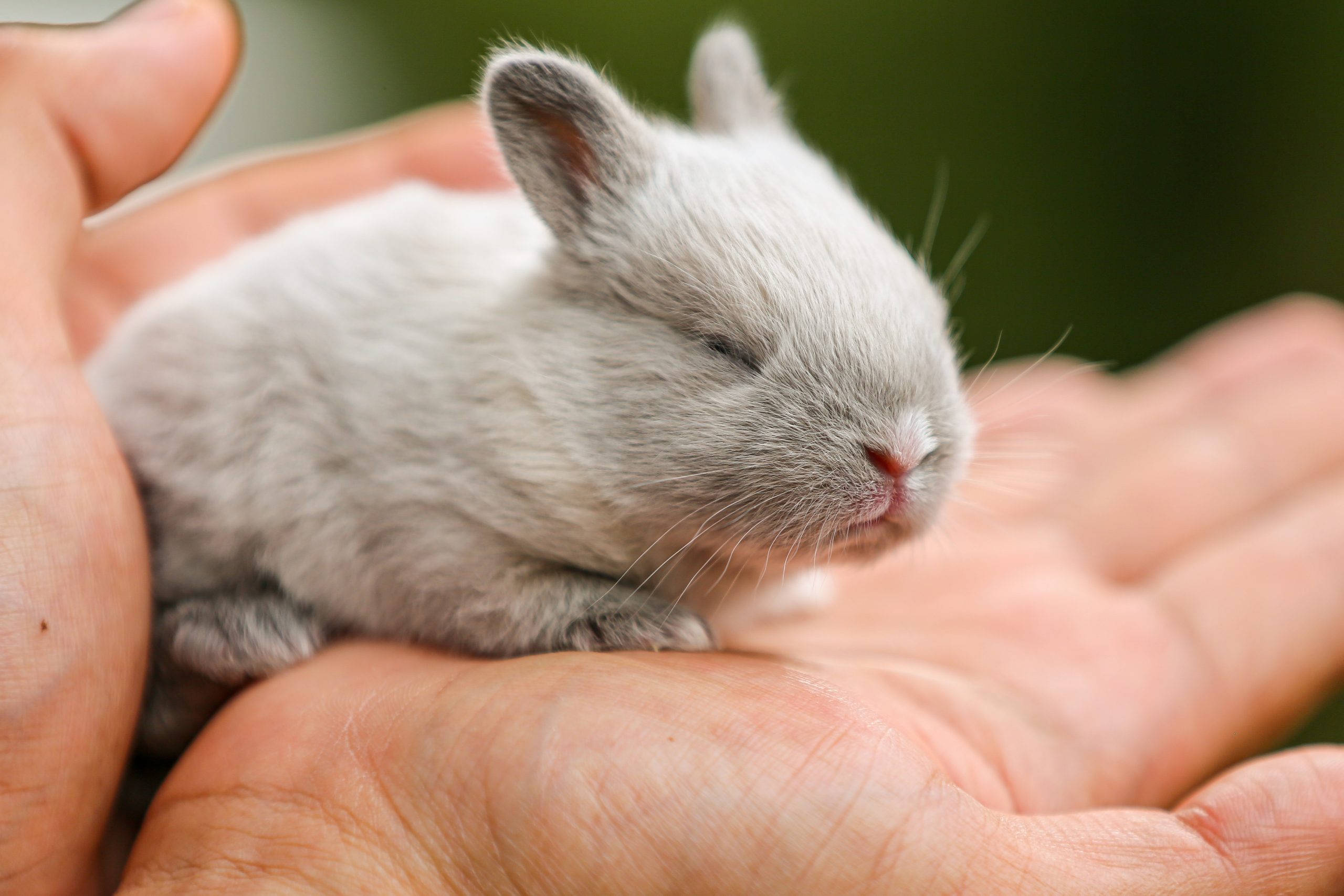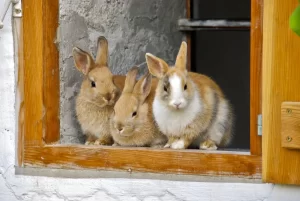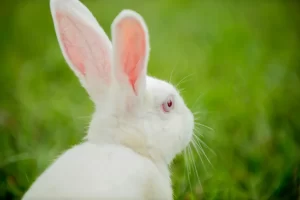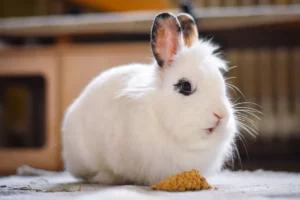Do you ever wonder how rabbits communicate with each other? Well, you’re in for a fascinating journey into the world of rabbit communication.
From visual cues to vocalizations, scent marking to body language, rabbits have a wide range of ways to convey their messages.
Through this article, we will explore the various methods that rabbits use to communicate, shedding light on their intricate and captivating world of non-verbal communication.
So, let’s dive in and discover the secrets of rabbit communication!
In This Article
- 1 Key Takeaways
- 2 Visual Communication
- 3 Vocalizations
- 4 Scent Marking
- 5 Body Language
- 6 Thumping
- 7 Licking and Grooming
- 8 Bonding Behaviors
- 9 Frequently Asked Questions
- 9.1 How Do Rabbits Communicate When They Are Feeling Threatened or Scared?
- 9.2 Do Rabbits Use Any Specific Body Language to Show Affection Towards Their Owners?
- 9.3 What Are Some Common Vocalizations That Rabbits Use to Communicate With Each Other?
- 9.4 Can Rabbits Use Scent Marking to Establish Dominance Within Their Social Group?
- 9.5 How Do Rabbits Communicate With Their Offspring During the Bonding Process?
- 10 Conclusion
Key Takeaways
- Facial expressions, such as flattened ears or perked up ears, convey the emotions and attentiveness of rabbits.
- Vocalizations, including growling, screaming, and purring, are crucial for survival and effective communication.
- Scent marking, through scent glands on the chin, chest, and near the anus, is an important form of communication for rabbits to establish dominance, boundaries, and attract mates.
- Body language, including facial expressions, ear positions, and overall body posture, provides insights into the mood and intentions of rabbits. Observing and understanding their body language helps in providing appropriate care for rabbits.
Visual Communication
You can observe rabbits using visual cues to communicate with each other. Facial expressions play a crucial role in their communication. For example, a rabbit may flatten its ears against its head when feeling threatened or frightened. This signifies that it’s in a defensive or submissive state. On the other hand, if a rabbit’s ears are perked up, it indicates attentiveness and curiosity.
Posture and positioning also contribute to their communication. When rabbits are relaxed and content, they’ll stretch out their bodies and lie down with their hind legs extended. Conversely, if a rabbit is feeling agitated or ready to flee, it will adopt a crouching position, with its body low to the ground and its muscles tense.
Vocalizations
When rabbits feel threatened or scared, they use different vocalizations to communicate. These vocalizations serve as a way to warn others of potential danger and establish dominance. Here are three types of vocalizations rabbits use:
- Growling: Rabbits produce low, guttural sounds when they feel threatened. This growling is a clear warning to others that they should back off and avoid any potential conflict.
- Screaming: When rabbits are in extreme distress or pain, they emit high-pitched screams. These screams indicate that they’re in danger and need immediate assistance.
- Purring: Contrary to popular belief, rabbits can also purr. This soft, rhythmic sound indicates contentment and relaxation. They often purr when they’re being groomed or when they’re enjoying a comfortable environment.
Rabbits have a hearing range that extends beyond that of humans. They’re highly sensitive to sounds and can detect subtle changes in their environment. These warning calls are crucial for their survival, allowing them to communicate effectively and stay safe.
Scent Marking
To establish their territory, rabbits mark their surroundings with their scent glands, leaving behind a distinct odor that warns other animals to keep their distance. This territorial marking is an important form of communication for rabbits, allowing them to assert their dominance and establish boundaries. Rabbits have scent glands located on their chin, chest, and near their anus. These glands produce a mixture of chemicals that are secreted onto objects, such as rocks, trees, and even their own fur. Through this process, rabbits are able to communicate valuable information to other rabbits in the area. For example, the scent left behind can indicate the presence of a dominant rabbit or convey information about mating availability. Additionally, rabbits also communicate through urine, using it to mark their territory and communicate their presence to other rabbits. This form of communication is particularly important during the breeding season when rabbits are looking to attract mates.
Body Language
By observing a rabbit’s body language, you can gain valuable insights into their mood and intentions. Rabbits communicate through a variety of body signals, including facial expressions and ear positions. Understanding these cues can help you better serve their needs and provide appropriate care. Here are three key body language signals to look out for:
- Facial expressions: A relaxed rabbit will have a soft, relaxed expression with their eyes half-closed. However, if they’re feeling threatened or agitated, their eyes will widen, their nostrils may flare, and their mouth may be tense and closed.
- Ear positions: Rabbits use their ears to communicate their emotions. When they’re relaxed and content, their ears will be in a neutral position. But if they’re curious or alert, their ears will be erect and facing forward. Conversely, if they feel threatened or frightened, their ears may flatten against their back or even lay completely flat.
Thumping
You can easily recognize when your rabbit is feeling threatened or alarmed by the loud thumping sound they make with their hind legs. This behavior, known as thumping, is a warning signal that rabbits use to communicate danger. When a rabbit feels threatened, they will rapidly and forcefully thump their hind legs against the ground, creating a distinct sound that can be heard from a distance. Thumping is a form of territorial behavior, as rabbits use it to warn other rabbits or animals to stay away from their territory. It is important to pay attention to your rabbit’s thumping behavior, as it can indicate potential threats or disturbances in their environment. By understanding and responding to their warning signals, you can ensure the safety and well-being of your furry friend.
| Warning Signals | Territorial Behavior |
|---|---|
| Thumping | Marking with scent |
| Growling | Chasing intruders |
| Ears pinned back | Lunging |
Licking and Grooming
When your rabbit licks and grooms themselves, it’s a natural behavior that helps them keep their fur clean and free of tangles. But it’s not just about cleanliness; grooming also plays a vital role in bonding and establishing social hierarchy among rabbits.
Here are three key aspects of rabbit grooming:
- Bonding through grooming: Grooming is an essential part of rabbit socialization. When rabbits groom each other, it strengthens their bond and promotes trust within the group. By engaging in reciprocal grooming, rabbits demonstrate their acceptance and affection for one another.
- Social hierarchy: Grooming also serves as a way for rabbits to establish their social status within a group. Dominant rabbits often initiate grooming sessions, asserting their authority over subordinate rabbits. Submissive rabbits will reciprocate by grooming the dominant rabbit, reinforcing their lower rank in the social hierarchy.
- Mutual grooming benefits: Besides its social significance, grooming has practical benefits for rabbits. It helps distribute natural oils throughout their fur, keeping it healthy and preventing matting. Additionally, grooming allows rabbits to remove dirt, debris, and parasites from their coats, ensuring optimal hygiene.
Understanding the importance of grooming in rabbit behavior can help you provide a conducive environment for your furry friend’s social and physical well-being.
Bonding Behaviors
Rabbits bond through grooming, reinforcing their social connections and trust within the group. Social interactions play a crucial role in their bonding behaviors.
When rabbits groom each other, they engage in a reciprocal behavior that promotes a sense of belonging and unity within the group. Through grooming, rabbits establish a hierarchy and maintain social order. This behavior also helps in stress reduction and promotes a sense of security and comfort amongst the group members.
In addition to grooming, play behaviors are another important aspect of rabbit bonding. Playful activities such as chasing, hopping, and running together not only provide physical exercise but also strengthen social bonds. These play behaviors help rabbits establish trust, enhance cooperation, and improve communication within the group, ultimately leading to a harmonious and well-connected social structure.
Frequently Asked Questions
How Do Rabbits Communicate When They Are Feeling Threatened or Scared?
When feeling threatened or scared, rabbits communicate through threat signals, body language, and vocalizations. They may thump their hind legs, flatten their ears, or growl. They also use scent marking to establish dominance and bond with offspring and their social group.
Do Rabbits Use Any Specific Body Language to Show Affection Towards Their Owners?
Rabbits may use specific body language to show affection towards their owners. They might nudge you gently, lick your hand, or even flop onto their side, which is like a bunny hug.
What Are Some Common Vocalizations That Rabbits Use to Communicate With Each Other?
Rabbits use various vocalizations to communicate with each other. Understanding rabbit body language is essential in interpreting these signals. By recognizing different types of rabbit vocalizations, you can better understand their needs and emotions.
Can Rabbits Use Scent Marking to Establish Dominance Within Their Social Group?
Scent marking in rabbits is a fascinating behavior. It serves multiple purposes, such as establishing dominance within their social group. Through scent marking, rabbits communicate their territorial boundaries and their position in the social hierarchy.
How Do Rabbits Communicate With Their Offspring During the Bonding Process?
During the bonding process, rabbits communicate with their offspring through bonding behaviors and parental instincts. They use body language, vocalizations, and physical contact to establish a strong connection and ensure the well-being of their young.
Conclusion
In conclusion, rabbits possess a variety of communication methods to interact with their environment and fellow rabbits. Through visual cues, vocalizations, scent marking, and body language, rabbits are able to convey their intentions, emotions, and establish social hierarchies.
The rhythmic thumping serves as an alarming signal, while grooming and licking reflect bonding behaviors. By understanding and interpreting these communication clues, we can gain valuable insight into the intricate world of rabbit communication.
So hop on and explore the fascinating language of these furry creatures!





